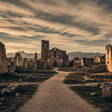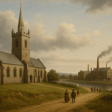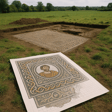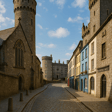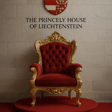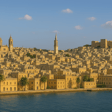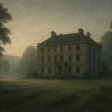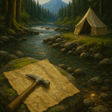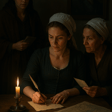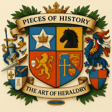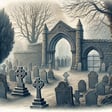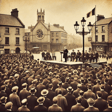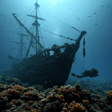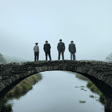Introduction to Rathmullen's History
00:00:14
Speaker
Hello and welcome to Pieces of History. I'm Colin McGrath and in each episode explore both the well-known and the overlooked stories that have shaped our world. Today we're travelling to Rathmullen, a village on the shores of Lough Swilly, steeped in history and rich with stories that reach far beyond its size.
Deirdre Freel's Journey into History
00:00:33
Speaker
I'm joined by local historian and guide Deirdre Freel as we uncover the moments and figures that have made Ralph Mullen such a unique place in Ireland's past. From clan power and rebellion to war, legend and memory.
00:00:48
Speaker
Deirdre, thanks very much for joining me. I really appreciate it. So before we get into the history of Ralph Mullen itself, to start off, can you tell me a little bit about yourself, your background and what first sparked your interest in history?
00:01:01
Speaker
Okay, Colin, so thanks very much for having me on your podcast. I'm delighted to be here. So um I've been living in Milford and Donegal for the last ah well, for over 40 years.
00:01:15
Speaker
and But prior to that, I actually grew up in Killie Beggs, the fishing port of Killie Beggs, which is in the south of the county. And prior to that, I actually lived in New York for a small number of years until I was six years old.
00:01:31
Speaker
So um the story there is that my parents emigrated from Ireland in 1947. and They met out in New York, they got married and they had their family and then they came back to Donegal.
Influence of Storytelling and Education
00:01:43
Speaker
and So I think really what sparked my interest in history, I was very curious as a child. I was always ah reading historical fiction and I love stories about heroic people and adventurers and and adventures and things like that.
00:02:03
Speaker
So another influence would have been my mother. She was a great storyteller herself. She came from Ballinalee in County Longford. And she grew up in the 1920s and she had these very, um you know, it it was very much in her memory, the stories of the black and tans in Longford in the 1920s.
00:02:27
Speaker
She lived only two miles away from General Sean McKeown, who was the blacksmith of Ballinalee, who was the leader of one of the IRA columns there. And she had these, as i say, very um very strong memory and and very graphic stories about the atrocities that were carried out by the black and tans and on one occasion the black and tans actually came to their house and put the whole family out in the buyer for nearly two days while they waited to ambush uh general mcconn but fortunately he didn't pass by on that particular occasion
00:03:07
Speaker
um But, you know, even though even years and years and I mean, my mother lived to 102, you know, she still had that in her memory, you know, that those those are awful times and that, you know.
Transition to Tour Guiding
00:03:20
Speaker
and I studied history at UCD and then my career path took me into the civil service and I worked in the Department of Agriculture and I worked in the court service as a court clerk in Donegal and Letterkenny.
00:03:37
Speaker
And then while I was working in the civil service, I took a three year career break. I was the coordinator of a heritage project um in Remelton. And I think that's what really ignited my interest in local history because we were researching the history of the town and we were indexing the parish registers.
00:03:58
Speaker
And I really ah sort of got very interested in the characters and the events that had shaped at the history of the town. So I think, yeah, but that's me. That's where I've come from to what what I'm doing today.
00:04:13
Speaker
That's an absolutely fantastic background in your family history as well. So moving on a wee bit in your professional life, how did you become involved in guiding tours and what would you say you enjoy most about sharing Rathmullen's story with local and international visitors?
00:04:29
Speaker
Okay, so as I said, i was working in the civil service for nearly 30 years. And then in 2009, I of the incentivized scheme for early retirement, ah which meant that you anybody over 50 could retire with a pension with your service up until then. So um I was very fortunate to get that because I was just at that stage, I wanted something different.
00:04:55
Speaker
And then um the following year I took part in a a course on tour guiding in the letter Kenny it. And after that, I got a regional guiding badge so I meant I could guide in the northwest of Ireland and then in 2020 I took part in another part of a course where I became a national tour guide so now i am a national tour guide and I'm also a member of the tour guides at gate the tour guides association of Ireland
00:05:31
Speaker
so when i first qualified as a tour guide in 2011 there really was no demand for tour guides it was prior to the wild atlantic way which didn't happen until 2014. so i said right i'm going to set up my own little business called donegal heritage trails and I'm going to do walking tours in Rathmullen and Remelton.
Connecting History with Landscape
00:05:55
Speaker
So that's what I did. And then around the same time, then the cruise ships had started to come into Kelly Beggs and um I got work there as a step on guide for the excursions for the cruise ships for Kelly Beggs and Greencastle.
00:06:12
Speaker
And that's a business that has taken up, ah has really, really um developed. And this year alone, 24 cruise ships came into Kelly Beggs. So um that's that's lovely. And that's a great opportunity to meet international visitors and it's just visitors from Europe and from America and that as well.
00:06:33
Speaker
And then since the Wild Atlantic Way has happened, there has been a ah lot of demand now for qualified tour guides. So I find now that I'm getting busier, much busier than I was 10 or 11 years ago.
00:06:49
Speaker
um And I, as well as doing my walking tours during the summer, I do tours for school groups, retirement groups, history groups. and wedding guests that come to Rathmullen. So a lot of people, you know, contact me and they're just, you know, they're looking for wee tour.
00:07:07
Speaker
And sure, I mean, Rathmullen is such a beautiful place to walk around, to even if I said nothing. and So, um yeah, I find now I'm a lot busier. And I just love sharing the history and bringing the stories alive.
Significant Historical Events
00:07:23
Speaker
And particularly i love finding a fact that not even the locals know. I love surprising people. And at the beginning of the tour, I find out where where people are from.
00:07:35
Speaker
and I love making a connection maybe from their country or from where they live with Rathmullen. And as I said, it's such a beautiful location. like sure it's It's just lovely to walk around it anyway.
00:07:48
Speaker
It is. it's i have to say, if anyone anyone's ever been to it, they know how stunning it is. The beach and the the coast looking across Loch Swelley over to Bunkhrana as well. as it's It's beautiful. I love it. I go there quite often to my myself. so yeah So if we kind of turn to Rathmore itself and the history, Deirdre, um what do you think makes the village such a ah unique place within Aaron's past?
00:08:13
Speaker
Well, as you just said, the location, location, location. I mean, Ralph Mullen is situated on Lockswilly. And Lockswilly is a ah glacial fjord that was formed 10,000 years ago.
00:08:28
Speaker
It's 40 kilometers long. it's a very um It's a very safe harbor and it's a very deep harbor. And it kind of ah provides a sort of a refuge from the, you know, the the rough seas of the Atlantic and everything.
00:08:46
Speaker
And because of that, um a lot of maritime events have happened there. And of course, the three most important and significant events have been the flight of the eras in 1607, the the ah attempted invasion ah by Wolf Tone in 1798.
00:09:09
Speaker
And it became the headquarters of the um the Grand Fleet at the start of World War I. So they're sort of and the main events that have happened there.
00:09:21
Speaker
And of course, for Rathmullan in particular, um it has to be the Flight of the Errors. I mean, it it's such a significant event in Irish history.
00:09:31
Speaker
And it just, um they sailed from Portamurray, which is just but just less than two miles outside the town, And I mean, the story is is just an amazing story. um How the the last significant eras of Ulster, ah Rory O'Donnell, Hugh O'Neill and Coo Connacht McGuire ah came to Rathmullen and got on a ship, 99 on the ship, sailed out of Luxwilly, intending to go to Spain, ended up in Leuven and eventually made their way to Rome.
00:10:09
Speaker
where unfortunately they all died um under and a few of them are buried there in Rome. It's just an amazing story and it's unique because you know it didn't happen anywhere else in Ireland and it's just very much part of of of the story of Rathmullen. And in 2007, it was the 400th anniversary of the flight of the earls and there was a whole week of commemoration.
00:10:36
Speaker
And the president of Ireland at the time, Mary McAleese, she came and she unveiled a sculpture by John Behan. And also there was a performance of and Brian Friel's play, Making History.
00:10:51
Speaker
There was very and eminent historians of the time came and discussed the whole background to the flight. And there was just, there so many events happened, you know, so that that happened in 2007.
00:11:04
Speaker
So I think that's really what singles Rathmullen out above anywhere else, you know.
The Abbey and its Legacy
00:11:09
Speaker
The flight of the arts themselves, David, there could be a whole podcast series in themselves. And and I'm sure somebody, if nobody else has done it, I certainly will. So let's just see how goes. um If we go back a little bit to one of the key um families within the area, the McSweenies and the Abbey itself,
00:11:27
Speaker
Could maybe give us a bit of a background about who the McSweeney's were and exactly whereabouts the Abbey is and and what part of history the Abbey has within Rathamallon itself and also the connection to Davy Crockett?
00:11:40
Speaker
So yeah, the Abbey, well, the Abbey is the oldest building in the town. It was built in 1516. So, and it was built um by the McSweeney. So we're, Rathmullen has a very big connection with the whole Gaelic Lordships and of course the O'Donnells. So from the 1200 to the 1600s, Donegal was ruled by the O'Donnells, a very powerful and family.
00:12:10
Speaker
So a descendants of the Kinnel Connell, Donegal's a big county. And um as well as that, they were always, I have to say, they were always fighting. and They were fighting among themselves. They were fighting against the English and they were fighting with other Gaelic chieftains as well.
00:12:27
Speaker
So in the thirteen hundreds um Three branches of the Muxivnas, the McSweenies, were brought over from Scotland over to Donegal.
00:12:38
Speaker
um Two of them were given lands in North Donegal. You have the McSweenies of Fanad, on the Fanad Peninsula, and the McSweenies of Doe, where you have Doe Castle. And then the other McSweenies were the McSweenies of Banna, which is down near Kellybeggs, St. John's Point, down near Kellybeggs.
00:12:57
Speaker
So and the McSweeney's of Fanid in return, and they were known as um mercenaries. They were gallo glasses. They were professional fighting men.
00:13:08
Speaker
And in return for providing fighting men for the Donegal, for the O'Donnell armies, They were given tracts of land. So the McSweeney's of Fanet were given the whole Fanet Peninsula, which went from a Fanet Head right up to Remelton, which is is quite a significant piece of land.
00:13:29
Speaker
So they were given that land in return for providing and soldiers for the O'Donnell army. So the McSweeney's had and three castles. They had two down in Fannet.
00:13:40
Speaker
And then um they built a castle in Rathmullen just across from the abbey. There's a promontory there. It's called Hilly Head. It's also called Ardy Gashel, the height of the castle.
00:13:52
Speaker
so that was built at the end of the 1400s now at the beginning of the 1500s one of the children died rory oak and he was buried in the piece of land where the abbey is and his mother was very religious she was one of the o'malis from the west of ireland and she wanted a monastery erected where the child was buried So um they built the McSweeney's built this monastery ah in it was completed by 1516. It's called the Abbey.
00:14:25
Speaker
It's called the Friary and it's called St. Mary's Priory, but it's generally known as the Abbey. Mrs McSweeney was very religious. She lived across in the castle and she came over three times a day for mass.
00:14:40
Speaker
ah in the Abbey and the Abbey was given to the Carmelite Order from the West of Ireland and they they sort of they ran the Abbey there. Her prayer book is in the Royal Irish Academy, Moira Mac Sweeney.
00:14:57
Speaker
it continued as a monastery up until um the end of the 1500s and even during the time of the um the dissolution of monasteries in 1537 during the reign of henry the eighth when all the other monasteries throughout ireland were being closed the carmelite order came up to Donegal, came to this monastery, and that became their headquarters because it was under the protection of the O'Donnells. And at that time, the O'Donnells were very powerful.
00:15:30
Speaker
So and as I say, the the monks were there until about 1595, but um evidence shows they had left at that stage. And we know at the beginning of the 1600s, there was a garrison of 100 soldiers were stationed there.
00:15:45
Speaker
And then, of course, 1607, the flight of the Earls. And then after that, then um the lands were all confiscated and given to English and Scottish settlers.
00:15:58
Speaker
And the person that that. got the Abbey was Bishop Andrew Knox of Scotland and he came as the um first Protestant Bishop of the Diocese of Riffel and he decides to move into the Abbey and he converts it into a fortified house and he has uh 25 horsemen and 15 soldiers stationed in the vicinity of where he lived and he starts to bring the first settlers into rathmullen so that's when the the village of rathmullen um uh sort of begins in at that time in the 1600s um the family lived there for more or less a hundred years
00:16:41
Speaker
and then they move over to live in prehen house in dairy and the um the abbey becomes vacant now most of it is vacant apart from one part which had been the the bishop's private chapel um the church of ireland community in the town ah They needed a new church and their church had fallen into disrepair.
Red Hugh O'Donnell's Legacy
00:17:05
Speaker
So they got permission to come in and have it changed. and The private chapel became a parish church. So for over 100 years, it was the parish church for the Church of Ireland until they built St. Columns Church in 1814.
00:17:20
Speaker
And that's where the story of Davy Crockett comes in because Story has it David Crockett's great great grandparents came across the water and his great great grandmother was Sarah Stewart from Manor Cunningham, Bally Lawn and Manor Cunningham and the Crockett's lived on the other side as well and they came over and they got married there um ah around 1702 and then they subsequently I think around 1706
00:17:56
Speaker
They sail to America and they're the great, great grandparents of Davy Crockett, king of the wild frontier. So, yeah, so it it it has, it's very much, there's a lot of stories, you know, the McSweeney. So in the graveyard, you have the McSweeney's are buried there.
00:18:16
Speaker
You have the Knox's, the Knox family. um And then you have parishioners, you know, from the village as well. Do you mind if we talk about um another particular character you did touch on earlier on and the kidnap of of Red Hugh O'Donnell.
00:18:32
Speaker
Could you talk us through that story and why it's remembered such a pivotal moment within the history? Yes, well, the kidnap of Red Hugh O'Donnell, as I said, the O'Donnells were very powerful. um His father lived down in Donegal Castle. the At that time, we're talking about 1587, the English were trying to work, beginning to control different parts of Ireland. They were having great difficulty with the Gaelic Lords.
00:18:57
Speaker
um They were trying to bring his father under their control. So um they they came up with a plan that um they heard they had spies everywhere. They heard that the young Red Hugh O'Donnell, who was only 15 years old, and that he was visiting the McSweeney's. I think he was visiting the McSweeney's at Dole Castle, but then they also came to Rathmullen Castle.
00:19:25
Speaker
And... he was staying there with them and a ship came in disguised as a Spanish wine boat and it just anchored literally in front of the abbey there.
00:19:36
Speaker
um So word was put out to the castle that they had some wines on board and the young O'Donnell came on along with some of the other Mac Sweeney's and when they got him on the ship they closed the hatches and off to Dublin Castle.
00:19:53
Speaker
So he was kept a prisoner there for four years. And just remember, he was only 15 years old. ah Both the O'Neill family and the O'Donnells tried everything to get him released.
00:20:06
Speaker
But it wasn't until m Christmas night, 1591. I think they got the jailer drunk um and himself and and two of the O'Neills who were also in the prison at the time, ah Hugh O'Neill and Art O'Neill,
00:20:23
Speaker
They ah tied um sheets together and they came down the sewage system of the castle and they got to the other side. Now there was supposed to be horses waiting on them, no horses.
00:20:36
Speaker
So they headed off on foot. into the dublin mountains it was as i said it was christmas the place was covered in snow they only had their prison um garb on them they weren't very well prepared for the um for the bad weather conditions and they made it so far into the dublin mountains uh but unfortunately art o'neill succumbed to hypothermia and he died under ninety thirty two the erected across there And there called Arts Cross at the spot where he died.
00:21:10
Speaker
and They had a guide with them and the guide left O'Neill, Art O'Neill and O'Donnell in a cave. And he headed off to Glenmallure in County Wicklow to Feeke McHugh, O'Byrne.
00:21:26
Speaker
And he got help. And when they came back, Art O'Neill had died. ah Hugh O'Neill or Hugh O'Donnell was still, um he was still alive. He was brought to Glen Malure for a few days to recuperate.
00:21:38
Speaker
And then he was brought back to Ballyshannon Castle. But unfortunately his feet were so badly frostbitten that the surgeons had to amputate his two big toes, which effectively left him disabled. And from then on he had to be helped on an office horse.
00:21:54
Speaker
So like he was only like 20 years old. Um, He then became um became the the leader of the O'Donnells. When he was 20, he was inaugurated at Doon Rock and Kilmer Crennan, and he became the leader of the O'Donnells. And he had a great hatred of the English for what they had done to him, that he fought the nine years war against them.
00:22:18
Speaker
And he was joined by Hugh O'Neill. And they had a number of they had a number of successes. and the 1595 the battle of clon tybert and 1598 the battle of the yellow ford but ultimately in 1602 they had sent for spanisht spanish help it had arrived in kinsale instead of in the north of ireland and they headed down to relieve the spaniards and um they were all defeated by the english at the battle of kinsale um
00:22:54
Speaker
hugh o'donnell did not red hugh did not come back to donegal he headed to spain to get more help and he was staying in samancus castle in spain and he died the following year some would say he was poisoned some would say he died of a tapeworm infection and he was buried in um valladolid in in spain and every for the last three years now there has been a reenactment of red hugh o'donnell's um funeral so there's great interest in red human down there was a time when they thought and they were doing excavations under um well turned out to be under a shopping center but it was actually the site of a very important church where he was buried and there was great excitement they thought they might find his body and
00:23:44
Speaker
Where was he going to be brought back to and all like that? But they didn't know. They didn't find his body there.
Rathmullen's Wartime Role
00:23:49
Speaker
But and there is the funeral reenactment every year. So, yeah, there's still a great. um He's still very much the hero and he's very much part of Donegal history.
00:24:03
Speaker
Read Hugh O'Donnell. But the kidnap happened at Rathmullen. Moving on slightly, if that's okay, could you tell us a bit about Wolf Tone? Now, there's again some listeners who maybe don't know who Wolf Tone is and how the French were in involved with Rathmullen and in the and attempted invasion of 1798.
00:24:24
Speaker
The 1790s was a sort of an and an age of enlightenment and people were very much influenced by what was going on in France, the rebellions in France.
00:24:36
Speaker
So in 1791, the United Irishmen were formed ah by um a group of Protestants and ah the leader was Wolf Tone.
00:24:47
Speaker
And they were trying to get um reform of the parliament in Ireland at that time. ah Catholics and Presbyterians couldn't sit in Parliament. So they were trying to get political reform um and ah also for the Catholics to to be able to sit in Parliament as well.
00:25:09
Speaker
And they believed in the equal representation for all people in Ireland. So Wolf Tone had been educated in France. And as I said, he he was very much influenced by what was going on in France and as well as that France was at war with England.
00:25:25
Speaker
So there was a kind of an opportunity to seek help from France. in the struggle against British rule in Ireland. Now in 1796, there was ah French forces were sent to land in Bantry Bay, but it had to be aborted.
00:25:45
Speaker
So that was failed. And then um in 1798, there was a French troops arrived in Calala in County Mayo.
00:25:56
Speaker
but they were defeated at the Battle of Balanamuk. So then in 1798, another, m another force were sent from france led by wolf tone himself and altogether about um 10 ships i think departed from france but they were intercepted they were heading towards locks willie but they were intercepted off ah tory island and it was a the battle of tory island some ships got away but roughly about his seven ships were arrested and three thousand sailors
00:26:32
Speaker
were brought into Lockswilly. Now among those was Wolf Tone. ah He was dressed as a French general and he spoke fluent French but unfortunately for him ah Tone had gone to college in Trinity as did one of the English generals and he identified him.
00:26:50
Speaker
So he was put in chains and sent to Dublin Castle and he was tried for treason. and he was sentenced to be hanged. ah But on the night before the hanging, he actually cut his own throat with a pen knife and he died a week later from the wounds.
00:27:07
Speaker
So that was that was what happened with Wolvetone. So after that, then the British were very worried that another invasion force would try and land in Lough Swilly. So um there had been a few temporary forts built along the Lough, but they were all and made stronger.
00:27:25
Speaker
And in Rathmullen, the battery was ah was built in Lough. which is still there to be seen now if you're visiting uh rathmullen today and um there was three three fourths on one side on the fan side and there was three so forts on the other side on the initial side so they were kind of the the guard posts uh for locks willie and as they would say once they were built the um the guns were never fired in anger
00:27:57
Speaker
So no other invasion force and ah tried to to come into Lockswilly. And then they kind of came into play again when the the Grand Fleet was in in 1914. But as I say, it was after that attempted invasion in 1798 by Wolftone that these forts were all built along Lockswilly.
00:28:17
Speaker
Could you tell us what role Rathamuddin played within the First World War and then the arrival of Grand Fleet, please? Right. Yeah, Rathmullen was was very pivotal during the World War One. So what happened was at the out outbreak of World War One, ah the Grand Fleet were to be stationed at Scapa Flow, which is a natural harbour in the Orkney Islands off the coast of Scotland or well part of Scotland.
00:28:45
Speaker
And um The Admiral of the Fleet, Admiral Jellicoe, didn't think it was sufficiently safe um from German attack. So in October 1914, he brought the Grand Fleet of Great Britain into Locks Willey.
00:29:01
Speaker
So that um at the time was 40
00:29:05
Speaker
between cruisers destroyers and repair ships and they were all um anchored ah within lockswilly and a boom which is a ah kind of like a metal net was put across the entrance to lockswilly to keep ah to keep the german submarines out of the law and Yeah, so the they at one time, now fortunately no German submarines ever did get in, but at one stage um after they arrived, and they went a few ships went out to do a gunnery exercise out further out of the law, out into the Atlantic.
00:29:47
Speaker
And one of them was called the the Audacious. And unfortunately, it struck a mine that had been laid just a few days previous by the Germans and the boat sank, completely sank. And it was it was one of their biggest boats.
00:30:04
Speaker
There was no loss of life, but and the British were very embarrassed at how easily it had been sunk. and they tried to keep it um they kind of tried to keep it under wraps but weren't successful word got out that it was lying out in the bottom of the out in the bottom of the water but um yeah so i mean apparently uh it must have been an amazing sight to all the uh all the ships in and admiral jellicoe spent his time between rathmullen he stayed in the pier hotel in rathmullen and also he stayed in buncrana and um
00:30:38
Speaker
With all the sailors um like that, that particular ship, now the audacious had a crew of 900. You know, unlike there were 40 ships. And so, I mean, I don't even know how many people at any one time, how many sailors would have been in Luxwilly.
00:30:55
Speaker
But they had a big job by keeping everybody amused. So they called on all the local m yacht owners and boat owners and to come. And they had regattas very frequently throughout the week.
00:31:09
Speaker
And then they walked them everywhere. They had them way off walking around the countryside and everything. and they built a recreation hall for them. And as well as that then there were kite balloons were stationed in Rathmullen. So these were kind of, um if a convoy of ships were, you know, crossing the Atlantic, they would be um accompanied by some of these and British naval ships and there would be men up in these balloons.
00:31:37
Speaker
where they could look out for submarines and everything. So um there obviously was a lot of activity in Rathmullen while that was all happening. And then now they only stayed in probably for a short period. I think they were gone by the end of November.
00:31:53
Speaker
But throughout the war, then the reserve fleet would have been in and out of Lockswilly. um So right up until the end of the war in 1918, there was a presence, a naval presence in Lockswilly.
00:32:08
Speaker
um And then um the the interesting thing was that in 1921, when we signed the treaty, ah the Treaty of Independence,
00:32:22
Speaker
um and you know the 26 counties were handed back to to the Irish government, and the British still maintained a presence in three ports in Ireland.
00:32:33
Speaker
So that was um Queenstown, which later became Cove, and Bearhaven and Cork, and Locks Willey. And that wasn't handed back to the Irish government until 1938.
00:32:46
Speaker
I think Winston Churchill named them the Sentinels of um the North. like But um yeah, ah so after that that, so then when the Second World War broke out in 1939, all the and the headquarters for the British and Navy and for the Canadians and the Americans was in
Maritime Disasters and Memorials
00:33:08
Speaker
But um yeah, so they were the treaty ports up until 1938. Could you tell us some of the fascinating tales about the HMS Saldana? Again, Deirdre, it's of those things I've actually never heard of it.
00:33:21
Speaker
So can you fill me in on that, please? Oh, very good. Oh, well, no, the Saldana is a big story. And as you say, if yeah um you know if you go to visit Fannad Lighthouse, there's a connection with that and you hear the whole story of the Saldana.
00:33:35
Speaker
So this the story of the Saldana is, so we're we're ah going to 1811.
00:33:42
Speaker
And at that time, um you know, there were always but would always have been a British presence. British Navy ships would have been in the law and.
00:33:54
Speaker
On the night of the 4th of December, 1811, there were two ships that had been out doing a patrol out in the Atlantic and they were making their way back into Lockswilly. Now the weather was very bad and the other ship was called the HMS Talbot.
00:34:09
Speaker
It made its way back back safely, but no sign of the Saldana. Now the Saldana was quite a big ship. It was 36 frigate ship.
00:34:20
Speaker
And it was captained by Captain William Packingham. But the next morning up at Ballamostocker Bay, which is that beautiful beach up as you head towards Fannet, there were all these bodies on the beach. Altogether, there were 254 of a crew and they all perished, even the captain.
00:34:41
Speaker
Now, the only thing that actually survived was the parrot. And a few months later, somebody shot down an unusual bird in their garden and it had a wee ring on its um leg, HMS Saldana.
00:34:58
Speaker
so it was it was the uh ship's parrot and it it was uh it was killed so um because of the large uh loss of life um the men the sailors were buried wherever they were found and there's a ah a mass grave on the 18th hole in port salin golf club that a lot of them are buried there and the others were buried just along the coast now the only one that i actually got a grave was captain packingham himself um He was a 26-year-old, as I say, captain of the ship.
00:35:31
Speaker
Now, his family were from Tully Nally Castle in County Westmeath, the Packinghams, and they're actually also known as the Lord Longfords. And there therere a family that um a lot, many people from the family served in the military and in the naval, and you know, as well.
00:35:53
Speaker
So there they were very well known. And his brother, so he's buried in a grave in the Abbey that I i talked about earlier.
00:36:04
Speaker
at His grave is there at the front. There's railings around it. So that's the grave of Captain Packingham. Now, Captain Packingham's brother was called Ned Packingham, and he led the British against the Americans at the Battle of New Orleans in 1814.
00:36:22
Speaker
um The British were very badly defeated by the Americans. The British lost 2,036 men, and the Americans under General Jackson lost 71.
00:36:35
Speaker
And ah there's there's a tradition in the family that you're buried where you fall. And that's why Captain Packingham was buried in Rathball. And now in the case of his brother, Ned, who died in New Orleans, he he his heart is buried under a pear tree, but his body was sent home in a casket of rum to preserve it. And it was sent back to Tully Nally Castle.
00:37:01
Speaker
And another interesting fact was Their sister, Kitty, was married to the Duke of Wellington. the man that defeated Napoleon at the Battle of Waterloo.
00:37:13
Speaker
So, and and then the Packingham family married into the Mahins of Strokes Town House and they became known as the Packingham Mahins. So quite an interesting family.
00:37:26
Speaker
ah Yeah, and that's that's the story of the Saldana. So after the tragedy happened, there was um an investigation by the British Admiralty as to how did this tragedy happen.
00:37:39
Speaker
um apparently the ship hit rocks on the way in they used to be called the swilly rocks they're now called the saldana rocks and the conclusion was that if there had been a light at fan it head uh which would have you know illuminated the rocks um it wouldn't have come you know it wouldn't have hit these rocks so it was after that then that they built a fan at lighthouse so that was built about I think it was opened in 1817, about six years later, they opened up Fannad
Preserving Rathmullen's Stories
00:38:09
Speaker
Lighthouse. And if you go and visit Fannad Lighthouse, you hear they've displays and everything.
00:38:14
Speaker
And you hear the whole story of the the sinking of the Saldana. yeah That's fantastic. The Pakenham family, that family her few must be absolutely extraordinary. Whoever Pakenham and is looking back through their family tree and maybe don't know those stories, they're in for a treat.
00:38:30
Speaker
Yes, yeah there's there's lots more. I'm sure. Actually, the current... yeah actually the the current ah resident of Tully Nally Castle is is a man called Thomas Packingham. He doesn't he doesn't use the title Lord Longford and he's an expert on he is the expert on Irish trees.
00:38:50
Speaker
He's written books on Irish trees. ah I think one of his books was called Conversations with Trees. As well, yeah. And he did come to Rathmullen. At one time we were having a commemoration to this um event and he did come and and was very generous talking about the family and everything like that. Yeah.
00:39:10
Speaker
Deirdre, I suppose ah but I'm going to say it's a whistle-stop tour of Rathmullen because we have covered several centuries and we've only really picked out a few individuals and events that have taken place. But can we hone in on your own experiences over your tour guide and...
00:39:25
Speaker
life so far. um So of all the stories, which one yourself would you find most visitors are surprised by whenever you're taking through the tour? Well, I would have to say the story and the one that I just love telling is the flight of the airs.
00:39:42
Speaker
You know, I mean, it's just, just it's hard. it's It's an amazing story. A lot of people that would come on the tours wouldn't know a lot about Irish history, you know, and Just to hear that story, to hear about the Earls, the heroic journey that they made to get to Rathmullen, 99 sailing off on a ship, intending to go to Spain, 21 days at sea, making an emergency landing in France, then being refused permission to go to Spain. So they went on to Leuven, which was in Spanish Flanders.
00:40:22
Speaker
um Then making and this other heroic journey, 1,100 miles over the Alps till they got to Rome. And then sadly, within a year, ah quite a number of them were already dead and they're buried in a church outside of Rome.
00:40:39
Speaker
So, I mean, just, and and um when they came to Rathmullen, Hugh O'Neill had to leave his seven-year-old son behind, calm, because they couldn't locate him.
00:40:50
Speaker
And he ended up in the Tower of London and ah Rory O'Donnell had to leave his wife, an unborn child behind. So just all the the sadness and the, the you know, and just having to leave their homeland and everything.
00:41:05
Speaker
And then, of course, what it means ah to um what it meant to ulster afterwards it marked the end of of gaelic leadership it marked the end of the brehon laws it paved the way for the plantation of ulster which totally changed the landscape of ulster so i just think when people hear that story just hear all the sadness um ah both the ah about the about the journey um and then you know and let's say what happened to them and then to hear
00:41:36
Speaker
the the repercussions it had for for Ulster. I think they're just, that they're quite amazed really. And they're just quite amazed that something as important happened in Rathmullen, you know, just a small and ah small little village, you know. So that's an amazing story. And I also think that the coming of the Grand Fleet,
00:42:01
Speaker
um as is one that people find quite amazing as well to think that all those ships were in there and all those sailors and that you know Rathmullen like when Scapa Flow wasn't suitable would bring them to Rathmullen you know so I think that that sort of um clicks with a lot of people as well and then the fact that Luxwilly was one of the treaty ports you know so I do i do think those stories are probably the are are the the number one stories and I always get that feeling when I'm telling the story of the flight of the Earls that you know as you walk along the shore you know what was it like the night they sailed out of Rathmullen and just you know leaving their homeland and and as I said even even leaving some of their family behind.
00:42:50
Speaker
Exactly and I think you've just touched on it Deirdre as well. You kind of forget whenever talking about these people it did happen several hundred years ago but they are people too. They did have sons, daughters, wives and they had to leave and ah essentially leave their homeland and never see it again. It's something that's completely alien to us now where you can jump on a flight and you go away on holiday and you come back again you've got your phone close by.
00:43:12
Speaker
While them it is it's just a completely different way of life almost and I personally feel whenever I'm reading these stories you kind of get desensitized almost to the fact they are humans and they have feelings themselves and the angst and worry and stress that they must be they must have been under while you're just kind of reading a page and you're like oh he did that and he did oh right fair enough uh Deirdre finally on a personal note then for yourself what does Sharon Ralph Mullins history mean for yourself?
00:43:40
Speaker
Well, I think in a way you just touched on it, Colin, you know, there where you were saying about ah we sometimes we get a bit desensitized when we read about these events in a book or, you know, where we Google it or something like that.
00:43:55
Speaker
ah and And that's what I like doing, you know, as a tour guide and sharing the history. It's telling the story of the place. Do you know what I mean? Like telling that story.
00:44:07
Speaker
that the hidden story of the facts. OK, you know, we might know the facts and that, but just, you know, that that the hidden story of of what really happened and that. So I like I just like sharing that and I just see i see my role as kind of the preservation of the history and, you know, as I say, retelling the story and even the flight of the herds 400 years later.
00:44:34
Speaker
You know, I'm still keeping it alive and I'm passing it on to the next generation as well, because, you know, from time to time, I do get school groups and, you know, just.
00:44:45
Speaker
just creating that interest in history because sometimes history is downgraded in school you know it's seen as as a kind of an opt-out and you know it's not given as as much i think maybe years ago history was more important or you know it was more considered more important on the curriculum and but um sometimes it's you know it's it's not considered like that now and um I just sometimes I get people that come and they say, oh, my gosh, you know, I did that subject at school, you know, or that particular period in history.
00:45:17
Speaker
But it didn't mean anything. But to come to Rathmullen, you know, and hear the story and to see where they left from and everything. So, yeah, so that's. ah You know, sharing the sharing in the history just gives me great.
00:45:31
Speaker
It just gives me great joy and it's a great honor. And as I say, I just I hope, you know, I am creating an awareness of like every everybody has their history, which is
Commemorative Efforts and Conclusion
00:45:45
Speaker
to every place but i think unless there's some way of sharing it and keeping it there in people's minds all the time you know it's very easy forgotten so um i think it's it's an honor the kind of work that i do that you know i can share it and keep it alive in people's memories and like in rathmullen every so often we might have an event to celebrate and well i don't know if celebrates the word but to commemorate um you know maybe that we had the four day 400th anniversary and then we had the 410th anniversary and we had the 415th anniversary you know and things like that so um yeah it's just and we had a lovely story i just i'll just finish on this
00:46:32
Speaker
We had a lovely um event last year. We were contacted by a lady who's an artist from Derry and McCloy, and she had spent um she got some sort of a bursary and she had spent ah was either three months or six months in um Rome in the church of San Montorio on her knees taking rubins from the grave slabs of the earls.
00:47:00
Speaker
So they're they're buried um in the church. Usually there's a carpet over and their grave slabs, which I haven't seen myself, but I have been told they're quite magnificent.
00:47:12
Speaker
And um they roll back, the the priest rolled back the carpet and she spent, as I say, I think it's three months and she took robins of um all that was you know written on the thing and the paper.
00:47:25
Speaker
the drawings and everything around it. So then she contacted us and she wanted to bring it back to Rathmullen. So we had to organize an event, which turned out very well. We we brought them in on a boat. She kind of got um these like small coffins made for the rolls. were quite big.
00:47:46
Speaker
And they were brought in and we had papers and we brought them into the hall in Rathmullen and people could kind of see it and everything. So in a way, we hear a lot about e the journey of Rathmullen to Rome.
00:48:01
Speaker
So this was the journey from Rome to Rathmullen. So it was it was a lovely event, you know, and we had some readings and. drama and everything so that that just happened now last year yeah so it's lovely to keep the the memory alive you know and i think just i just think generally that there's an unknown preset dented demand for irish culture and irish heritage at the moment know what i mean and i just think it's just wonderful to keep it alive and and there's lots of you know history groups and
00:48:33
Speaker
ah different people you know doing talks and things like that so it's it's just wonderful to be part of that. That was Deirdre Freel sharing her insight into the remarkable story of Rathmullen, a place where local stories have long echoed on a national and even global scale.
00:48:50
Speaker
Many thanks to Deirdre for guiding us through a journey that reveals just how much history can be found in one small village by the sea. If you ever find yourself in Ralph Mullen, take the time to wander at shorelines and streets.
00:49:02
Speaker
The past is never far away. Be sure to subscribe and rate Pieces of History on iTunes and Spotify and follow the podcast on Instagram and Facebook at Pieces of History.
00:49:14
Speaker
Thanks for listening.

